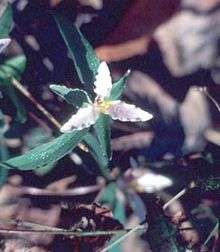Trillium pusillum
| Trillium pusillum | |
|---|---|
 | |
| var. virginianum | |
| Scientific classification | |
| Kingdom: | Plantae |
| (unranked): | Angiosperms |
| (unranked): | Monocots |
| Order: | Liliales |
| Family: | Melanthiaceae |
| Genus: | Trillium |
| Species: | T. pusillum |
| Binomial name | |
| Trillium pusillum Michx. | |
Trillium pusillum is a species of flowering plant in the family Melanthiaceae known by the common names dwarf wakerobin,[2] little trillium and dwarf trillium.[3][4] It is native to the southeastern and south-central United States from Oklahoma to Maryland.[1][5]
This is a perennial herb with a thin, branching, horizontal rhizome. It produces one or two slender scapes up to 20 centimetres (7.9 in) tall. They increase in size after flowering. The three bracts are dark green, sometimes with a red tinge when new. The flower has three green to red-tinged sepals up to 3 centimetres (1.2 in) long and 3 wavy-edged petals which are white and quickly age pink. The 6 stamens are tipped with lavender or yellow anthers each up to a centimeter long. The stigmas have long, narrow, spreading lobes. The pulpy fruit is 1 to 1.5 centimeters long.[3]
Trillium pusillum can be found in several habitat types, including savannas, swamps, bogs, forests and woods, and fields. It grows on acidic soils.[1] It is commonly pollinated by the western honey bee (Apis mellifera), and the seeds are dispersed by ants and harvestmen.[6]
Trillium pusillum has been divided into several varieties. Some authors accept only two, var. pusillum and var. virginianum.[3] The var. texanum is now treated as a separate species, Trillium texanum.[1]
References
- 1 2 3 4 Trillium pusillum. NatureServe. 2013.
- ↑ "Trillium pusillum". Natural Resources Conservation Service PLANTS Database. USDA. Retrieved 15 December 2015.
- 1 2 3 Trillium pusillum. Flora of North America.
- ↑ Kew World Checklist of Selected Plant Families
- ↑ Biota of North America 2013 county distribution map
- ↑ Andre, C. S., et al. (2005). Ecology of three populations of the rare woodland perennial, Trillium pusillum Michaux (Liliaceae) in southwestern Missouri. Missouriensis 26 7-21. (PDF)
External links
- Biodiversity Information Serving Our Nation (BISON) occurrence data and maps for Trillium pusillum ozarkanum
- Biodiversity Information Serving Our Nation (BISON) occurrence data and maps for Trillium pusillum pusillum
- Biodiversity Information Serving Our Nation (BISON) occurrence data and maps for Trillium pusillum virginianum
- "Trillium pusillum". Integrated Taxonomic Information System.
- "Trillium pusillum ozarkanum". Integrated Taxonomic Information System.
- "Trillium pusillum pusillum". Integrated Taxonomic Information System.
- "Trillium pusillum virginianum". Integrated Taxonomic Information System.
